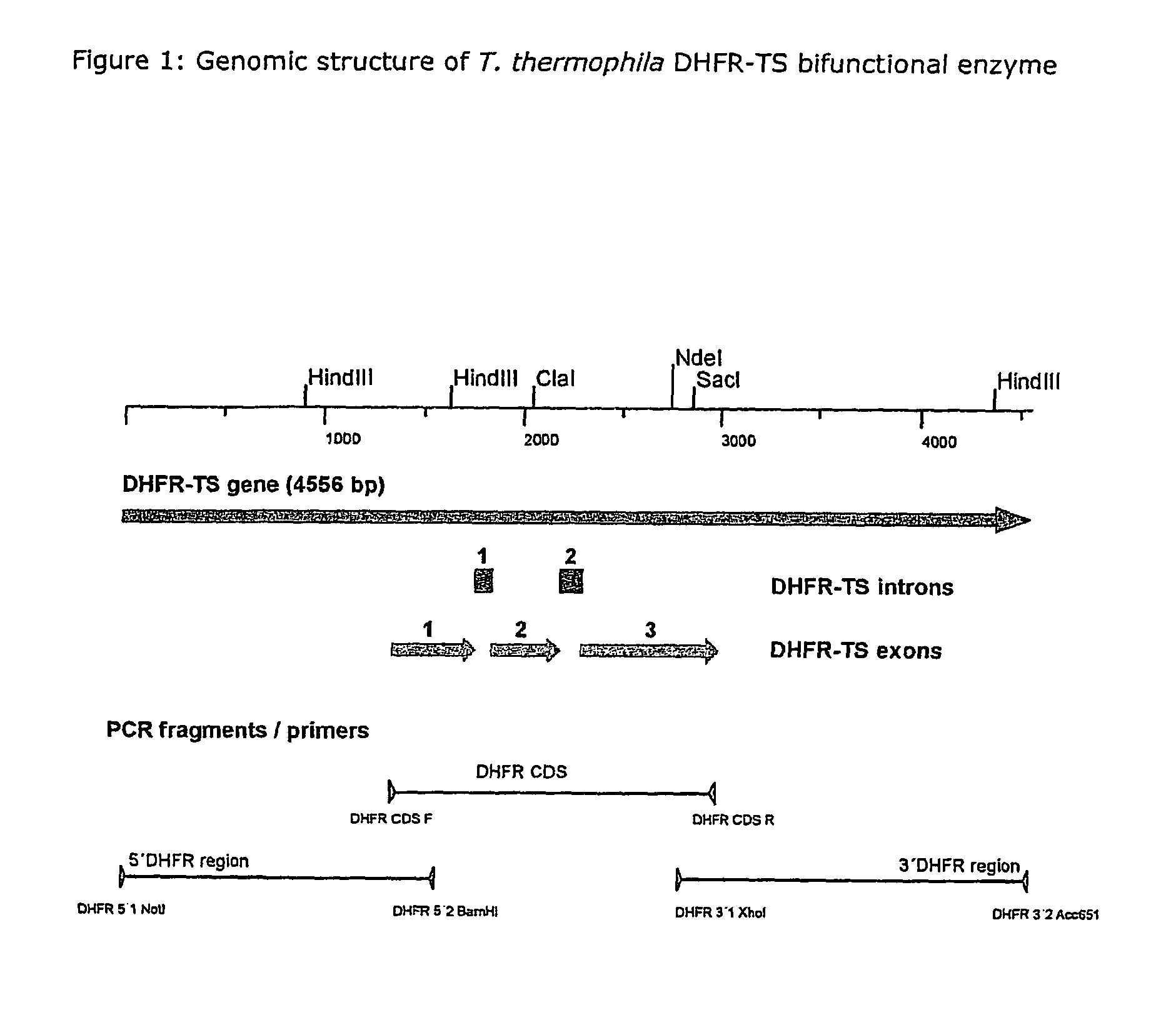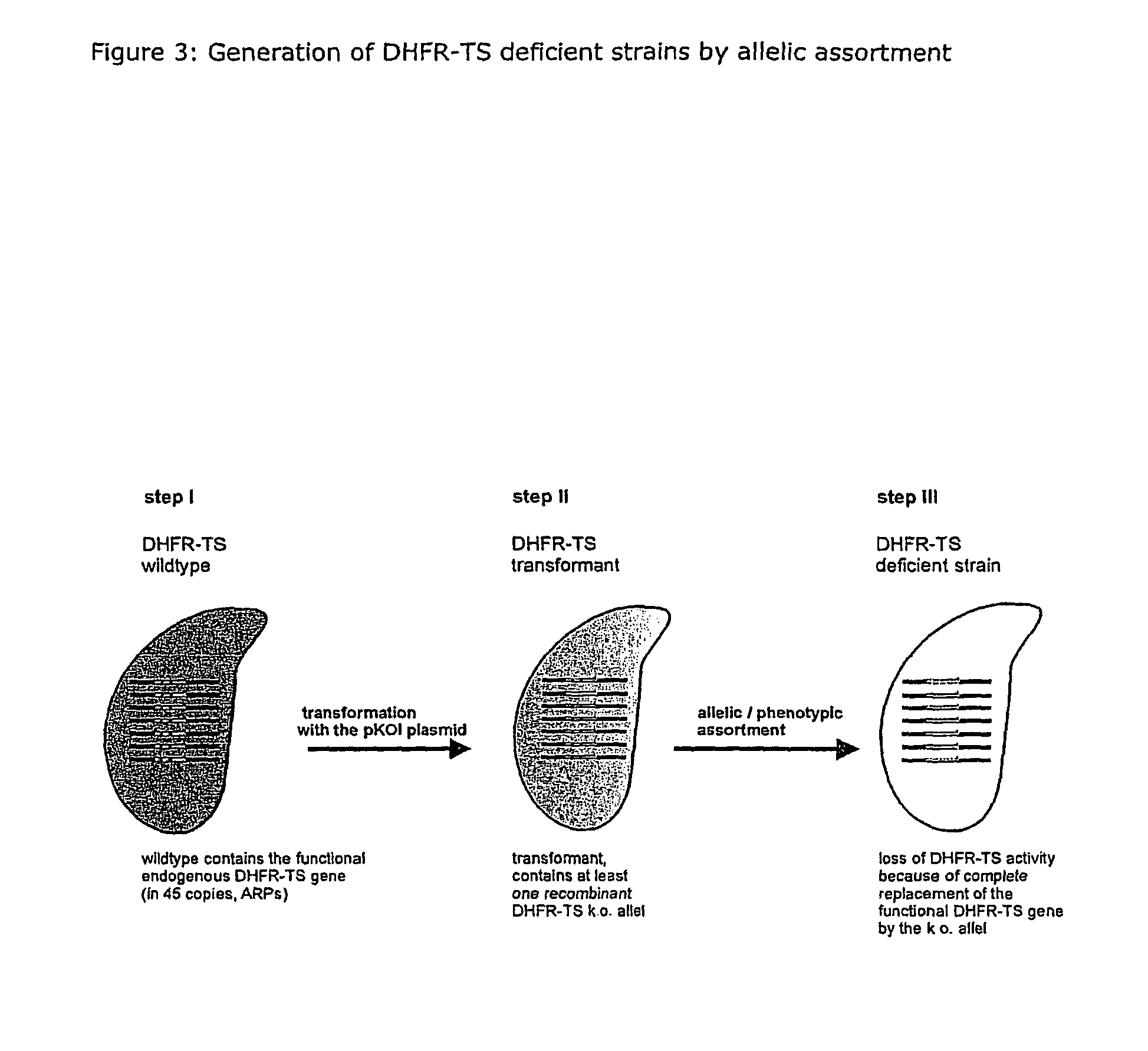Nucleic acid and its use effecting ciliate tetrahymena bifunctional dihydrofolate reductase-thymidylate synthase deficiency
a technology of dihydrofolate reductase and ciliate tetrahymena, which is applied in the field of recombinant molecular biology, can solve the problem of not having a true auxotrophic marker available that permits selection
- Summary
- Abstract
- Description
- Claims
- Application Information
AI Technical Summary
Benefits of technology
Problems solved by technology
Method used
Image
Examples
example 1
Generating Auxotrophic Heterokaryons
[0075]The protozoan T. thermophila belongs to the ciliates. These eukaryotes consist of two nuclei, a somatic macronucleus (MAC) and the genetic micronucleus (MIC). The MIC is the germline nucleus, i.e. it stores the genetic information for sexual progeny. The MIC is diploid and contains five pairs of chromosomes. In contrast to this the MAC is the somatic nucleus and no MAC DNA is transmitted to sexual progeny. The MAC contains 200-300 autonomously replicating pieces (ARP) that are derived from the MIC. Each of these units is present at about 45 copies except for the rDNA gene that is independently amplified to ca. 10000 copies per cell. The MAC DNA is the transcribed DNA and therefore responsible for the actual phenotype of T. thermophila cells.
[0076]It is obvious that genetic engineering ultimately needs the transformation of the functional MAC that is in charge of protein expression. The first approaches for heterologous expression were done b...
example 2
Knock Out DHFR-TS to Knock in the Gene of Interest
[0081]The knock out of the endogenous DHFR-TS gene of T. thermophila also provides the possibility to knock in a further foreign gene that can be expressed heterologously in the DHFR-TS knock out strains. For this purpose the pKOI DVL plasmid was constructed. It consists of a pKOI backbone with an additional expression cassette that encodes the first 115 amino acids (aa) of the precursor sequence of the PLA1 gene and the mature human DNase I (amino acids 23 to 281). Construct for the expression of the endogenous lipase contains the endogenous-Ciliate-lipase-prepro peptide sequence and the mature endogenous Ciliate-lipase.
[0082]The PLA1 prepro peptide (aa 1 to 110) has significant similarity to members of the cathepsin L family and mediates secretion into the medium. Similar to PLA1 prepro peptide the endogenous-Ciliate-lipase prepro peptide mediates the secretion of the lipase into the medium.
[0083]In the case of the DNase the five a...
example 3
Recombinant Reconstitution of DHFR-TS Activity to Create Strains for High Throughput Antifolate Screening
[0085]The reconstitution of the DHFR-TS activity in DHFR-TS deficient Tetrahymena strains can be done by heterologously expressing bifunctional DHFR-TS enzymes of other Alveolata. As already mentioned in the introduction, this phylogenetic group consists of the Ciliata, Dinoflagellata and Apicomplexa / Sporozoa. Especially the Apicomplexa are of high medical interest because all members are intracellular parasites and some of them cause very severe diseases (malaria, toxoplasmosis, cryptosporidiosis).
[0086]Apart from the fact that DHFR-TS deficient T. thermophila strains in combination with a DHFR-TS plasmid / vector provide a new marker for molecular biology, the same system can be used to generate defined test strains for drug development applications. Due to the close phylogenetic relationship it is also possible to recover the DHFR-TS activity in deficient Tetrahymena strains by ...
PUM
| Property | Measurement | Unit |
|---|---|---|
| concentrations | aaaaa | aaaaa |
| resistance | aaaaa | aaaaa |
| enzyme activities | aaaaa | aaaaa |
Abstract
Description
Claims
Application Information
 Login to View More
Login to View More - R&D
- Intellectual Property
- Life Sciences
- Materials
- Tech Scout
- Unparalleled Data Quality
- Higher Quality Content
- 60% Fewer Hallucinations
Browse by: Latest US Patents, China's latest patents, Technical Efficacy Thesaurus, Application Domain, Technology Topic, Popular Technical Reports.
© 2025 PatSnap. All rights reserved.Legal|Privacy policy|Modern Slavery Act Transparency Statement|Sitemap|About US| Contact US: help@patsnap.com



